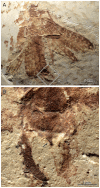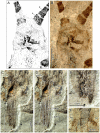Under cover at pre-angiosperm times: a cloaked phasmatodean insect from the Early Cretaceous Jehol biota
- PMID: 24646906
- PMCID: PMC3960115
- DOI: 10.1371/journal.pone.0091290
Under cover at pre-angiosperm times: a cloaked phasmatodean insect from the Early Cretaceous Jehol biota
Abstract
Background: Fossil species that can be conclusively identified as stem-relatives of stick- and leaf-insects (Phasmatodea) are extremely rare, especially for the Mesozoic era. This dearth in the paleontological record makes assessments on the origin and age of the group problematic and impedes investigations of evolutionary key aspects, such as wing development, sexual size dimorphism and plant mimicry.
Methodology/principal findings: A new fossil insect species, Cretophasmomima melanogramma Wang, Béthoux and Ren sp. nov., is described on the basis of one female and two male specimens recovered from the Yixian Formation (Early Cretaceous, ca. 126±4 mya; Inner Mongolia, NE China; known as 'Jehol biota'). The occurrence of a female abdominal operculum and of a characteristic 'shoulder pad' in the forewing allows for the interpretation of a true stem-Phasmatodea. In contrast to the situation in extant forms, sexual size dimorphism is only weakly female-biased in this species. The peculiar wing coloration, viz. dark longitudinal veins, suggests that the leaf-shaped plant organ from the contemporaneous 'gymnosperm' Membranifolia admirabilis was used as model for crypsis.
Conclusions/significance: As early as in the Early Cretaceous, some stem-Phasmatodea achieved effective leaf mimicry, although additional refinements characteristic of recent forms, such as curved fore femora, were still lacking. The diversification of small-sized arboreal insectivore birds and mammals might have triggered the acquisition of such primary defenses.
Conflict of interest statement
Figures







Similar articles
-
Ancient pinnate leaf mimesis among lacewings.Proc Natl Acad Sci U S A. 2010 Sep 14;107(37):16212-5. doi: 10.1073/pnas.1006460107. Epub 2010 Aug 30. Proc Natl Acad Sci U S A. 2010. PMID: 20805491 Free PMC article.
-
The first fossil leaf insect: 47 million years of specialized cryptic morphology and behavior.Proc Natl Acad Sci U S A. 2007 Jan 9;104(2):565-9. doi: 10.1073/pnas.0606937104. Epub 2006 Dec 29. Proc Natl Acad Sci U S A. 2007. PMID: 17197423 Free PMC article.
-
Stick insect in Burmese amber reveals an early evolution of lateral lamellae in the Mesozoic.Proc Biol Sci. 2018 Apr 25;285(1877):20180425. doi: 10.1098/rspb.2018.0425. Proc Biol Sci. 2018. PMID: 29695448 Free PMC article.
-
Behaviors and Interactions of Insects in Mid-Mesozoic Ecosystems of Northeastern China.Annu Rev Entomol. 2021 Jan 7;66:337-354. doi: 10.1146/annurev-ento-072720-095043. Epub 2020 Sep 11. Annu Rev Entomol. 2021. PMID: 32916066 Review.
-
Diversity, Form, and Postembryonic Development of Paleozoic Insects.Annu Rev Entomol. 2023 Jan 23;68:401-429. doi: 10.1146/annurev-ento-120220-022637. Annu Rev Entomol. 2023. PMID: 36689304 Review.
Cited by
-
A second view on the evolution of flight in stick and leaf insects (Phasmatodea).BMC Ecol Evol. 2022 May 12;22(1):62. doi: 10.1186/s12862-022-02018-5. BMC Ecol Evol. 2022. PMID: 35549660 Free PMC article.
-
Physical constraints lead to parallel evolution of micro- and nanostructures of animal adhesive pads: a review.Beilstein J Nanotechnol. 2021 Jul 15;12:725-743. doi: 10.3762/bjnano.12.57. eCollection 2021. Beilstein J Nanotechnol. 2021. PMID: 34354900 Free PMC article. Review.
-
Multifunctional Adhesives on the Eggs of the Leaf Insect Phyllium philippinicum (Phasmatodea: Phylliidae): Solvent Influence and Biomimetic Implications.Biomimetics (Basel). 2020 Nov 27;5(4):66. doi: 10.3390/biomimetics5040066. Biomimetics (Basel). 2020. PMID: 33261153 Free PMC article.
-
Adhesion Performance in the Eggs of the Philippine Leaf Insect Phyllium Philippinicum (Phasmatodea: Phylliidae).Insects. 2020 Jun 28;11(7):400. doi: 10.3390/insects11070400. Insects. 2020. PMID: 32605269 Free PMC article.
-
Independent wing reductions and losses among stick and leaf insects (Phasmatodea), supported by new Cretaceous fossils in amber.BMC Biol. 2023 Oct 9;21(1):210. doi: 10.1186/s12915-023-01720-0. BMC Biol. 2023. PMID: 37807035 Free PMC article.
References
-
- Labandeira CC (2013) A paleobiologic perspective on plant-insect interactions. Curr Opin Plant Biol 16: 414–421. - PubMed
-
- Sharov AG (1968) Filogeniya orthopteroidnykh nasekomykh. Tr Paleontol Inst, Akad Nauk SSSR 118: 1–216.
-
- Sharov AG (1971) Phylogeny of the Orthopteroidea; Theodor O, editor. Jerusalem: Israel Program for Scientific Translations. vi+251 p.
Publication types
MeSH terms
LinkOut - more resources
Full Text Sources
Other Literature Sources
Research Materials

